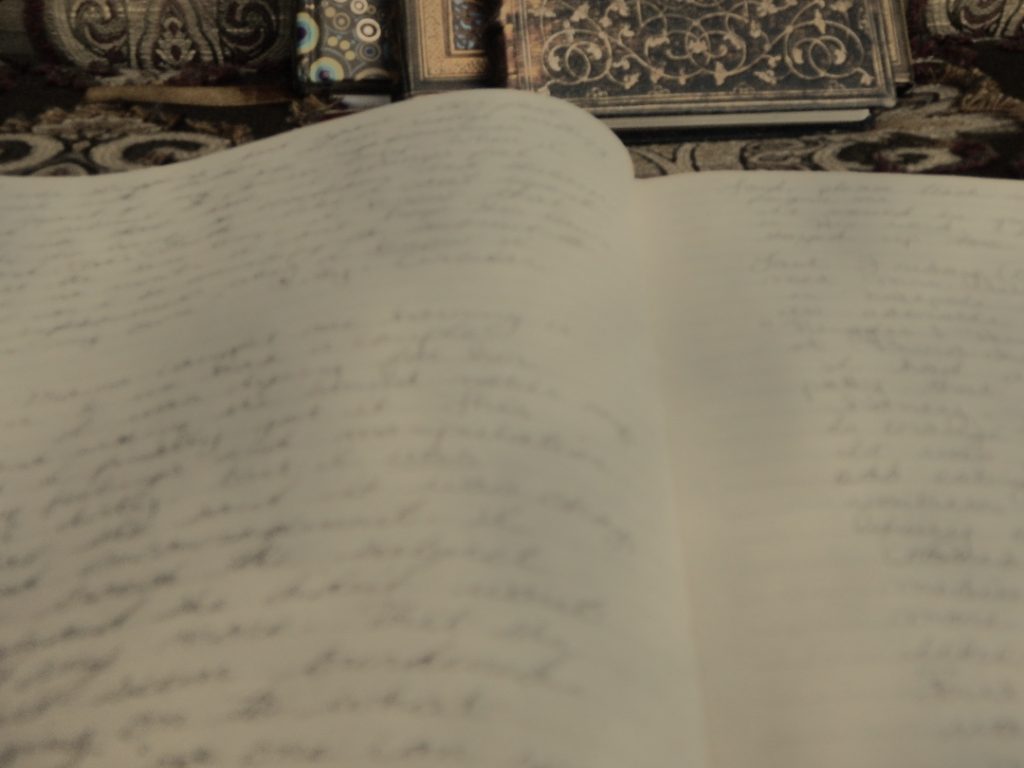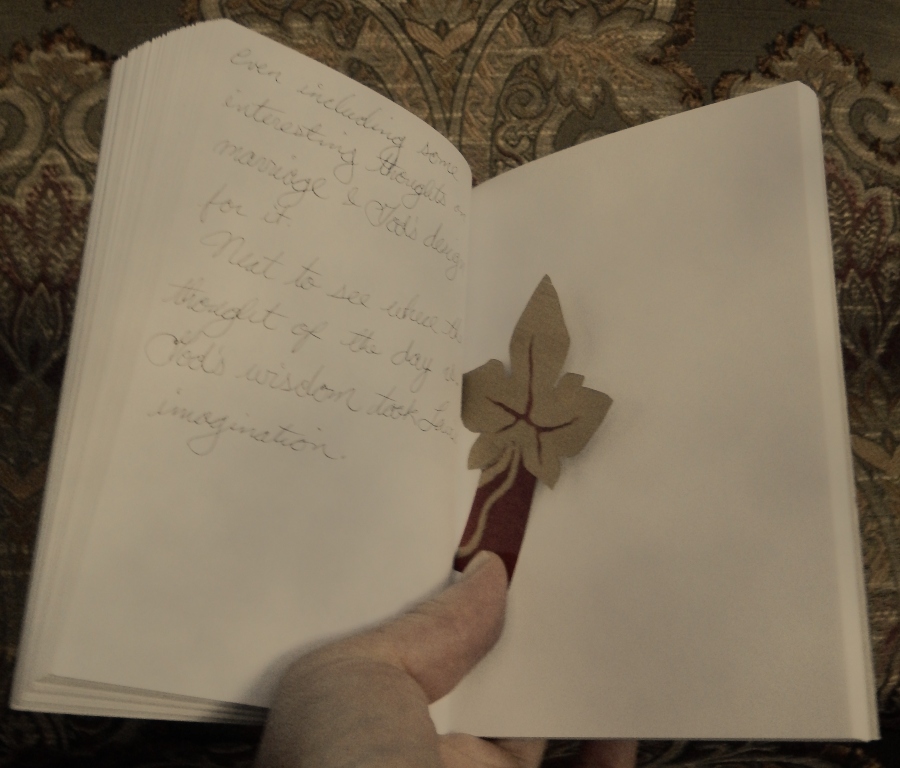I tried to think of a bunch of reasons why journaling is beneficial so I could share them in a compelling way and convince everyone who reads this post that they are seriously missing out if they don’t have at least one journal.
Honestly, I didn’t really manage it.
I love journaling – but the why is too personal and subjective to turn into a truly persuasive blog post.
So, instead of spending this whole post trying (in vain) to convince you to keep a journal, I’m going to assume you already want to keep a journal and move on to explore some general questions about journaling. I’ll talk a bit about how these general questions and answers apply to both personal, life-story journals and informational, record-keeping journals.
Here’s a Table of Contents so you can skip around instead of reading straight through if you’d prefer:
- What’s the Real Difference Between a Journal and a Diary?
- What Kind of Journal (or Diary) Should I Keep?
- What Sort of Book Should I Choose for a Journal?
- How Often Should I Add Entries to My Journal?
- How Much Time Does it Take to Journal?
- What Sort of Information Should I Include in Every Entry?
- What Do I Do With My Journal When It’s Full?
1. What’s the Real Difference Between a Journal and a Diary?
Answer: not much.
Here are the definitions in the Reader’s Digest1 dictionary that I use:
“Journal: 1. A diary or record of daily occurrences; especially, a ship’s log or logbook.”
“Diary: 1. A record of daily events; especially, a personal record of one’s activities, experiences, or observations; journal.”
Both words ultimately came into English from the Latin word dies, “day.”
Our word “journal” took a trip through Old/Anglo French to acquire its variant spelling, but it comes from the Latin diurnalis from diurnal, which can mean “daily.”
“Diary”, seems to have come a little more directly into English from the Latin diarium, which can mean “daily allowance” or – get this – “journal.”
So, whether you keep a journal or a diary is really all about your personal preference. But here are a few random thoughts to consider:
If you intend to head your life-story journal entries with “Dear ______,” then you may prefer the alliteration of “Dear Diary.” Somehow, “Dear Journal” just doesn’t have that charm.
But then, you may prefer a term that can double as a verb. You can’t diary, but you can journal. Journaling is an activity you most certainly can do, but diary-ing?
For me, the choice was made because I always felt that the term “diary” carried the connotation of a locked book of secrets – usually involving one’s latest crush. Since I was far more fascinated by the idea of imitating historians and explorers than aping boy-crazy teenagers, I went with “journal.”
Not that a journal shouldn’t be personal. My journals might not be locked, but I certainly wouldn’t use them as coffee table books.
2. What Kind of Journal (or Diary) Should I Keep?
Answer: that depends on what kind of information you want to record and why.
I’m hoping to talk about a few “genres” of journals in a bit more depth in the coming weeks. So, for now, I’ll just give a quick brainstorm of some types of journals I have kept.
- Life-story journal
- Prayer/Thanksgiving journal
- Travel journal
- Information journal – about my flower garden for example
- Idea journal – such as a notebook full of snippets and thoughts on poetry
- Sketch journal
- Quote journal
- List journal – such as a list of books that I’ve read
3. What Sort of Book Should I Choose for a Journal?
Answer: whatever fits your genre (and skills and inclinations) best.
Here’s where it really starts to get fun!
I don’t know about you, but blank books are fascinating to me! And if they look like old books and have pockets in the back or space inside the covers for some glued-on personalization, so much the better!
Here are a few options to think about as you choose a blank book to write in:
Will You be Writing in this Journal Often?
Then choose a design you fancy and a book that you enjoy holding. Something that lays open well is easiest to write in. And this doesn’t have to equal spiral-bound or pricey. One of the most comfortable journals I have had so far was a T. J. Maxx find.
Should You Choose Lined, Unlined, or Graphed/Bulleted Paper?
Lined is great if you’re like me and your handwriting tends to wander unless guided, and if you don’t tend to sketch or paste things into your journal.
You might want to try unlined paper or graphed/bulleted paper if you’re planning to do a bit of sketching as well as recording, or if you want to draw in plans — whether architectural, mechanical or otherwise. I’m hoping to use bulleted paper for my next garden journal so I can easily draw in some garden maps.
A bullet journal also seems like a must if you are going the route of making your own day-planner that doubles as a journal of the year. I haven’t tried one yet, but it looks so much easier to make clean-cut lists and calendars with the help of those evenly-spaced little dots.
Side note: be sure to match your book’s paper and whatever writing/drawing medium you plan to use.
Should You Choose Hard-Cover, Soft-Cover, Spiral-Bound…?

I tend toward hard-cover books with ribbon-markers. But some hard-cover journals are difficult to keep open, and therefore difficult to write in. On the flip side, they do seem to do well standing the abuse a journal gets from being hauled around, stuffed in various bags and pockets, and exposed to all sorts of out-door hazards.
However, one of my favorite journals was a soft, leatherette covered book with semi-flexible covers. It laid open beautifully and felt good against my hands. The binding eventually started to separate, but it lasted until I had filled it and packed it away.
Spiral bindings can lay perfectly flat, and they can also have hard covers. The only draw-back I have found is that the wire is bulky, and – in my opinion – unattractive.
A binding that I’ve recently become interested in is the disc-binding. I’ve always struggled with doing any kind of writing other than journaling in a notebook – all because of this one reason: I can’t move the pages around!!
Enter the disc-bound notebook.
If you are planning a journal that might be better off with movable pages, check into this kind of book.
Do You Want Extras?
Some journals have a pocket in the back; others have a pen loop or even a pen-holder on the cover. Some close magnetically, or with straps.
I love to have a pocket in the back of my journals, regardless of the “genre.” I keep all kinds of things in them from hand-drawn tables on what to feed geese to my new-year’s goals to candy wrappers from another country.
A strap, clasp, or magnetic flap can be super handy for keeping your journal closed – especially if your journal doesn’t have a pocket and you have a tendency to tuck loose papers into the back. A note of warning is in order, though: As wonderful as straps, flaps, and buckles may look, the more complicated they are, the more likely you will be to find them frustrating and therefore be tempted to leave your journal blank.
4. How Often Should I Add Entries to My Journal?

Answer #1: Well, it is a journal (diurnal), so technically one should make a daily entry.
(Better you than me.)
Answer #2: pick something doable and appropriate for your subject.
Here are a few suggestions:
- If you simply wish to record your life’s events, try writing once a week, or a couple of times a month – or even every couple of months. Unless of course you are chronicling a very special epoch in your life, in which case daily entries might be necessary. This approach should also work well with a topical journal like animal husbandry, or a list journal of, say, the books you read each year.
- If you are keeping track of something more scientific, like the weather, or how many eggs your hens are laying, then of course you will want to make daily entries. The same goes for travel journals as well.
If I may offer one piece of advice, especially for information journals – don’t believe the “I’ll remember” lie. Write it down sooner rather than later. You’ll most likely be thankful you did.
The subject of entry frequency leads to the next question –
5. How Much Time Does it Take to Journal?
Answer: that depends on how long it’s been since your last entry. (I speak from experience.)
It also depends on how distracted you get, or – conversely – how inspired you become once you start writing.
Sometimes I write for an hour or more. Sometimes, (more rarely) I jot down a quick entry that takes only a few minutes. If you’re planning to journal daily, I’d say 10 to 30 minutes. If journaling monthly — more like 30 minutes to an hour. But that’s a rough guess.
6. What Sort of Information Should I Include in Every Entry?
Answer: at least the date. Probably more.
You can add the day of the week, the time, the place, a weather notation, etc.
And be sure to make it fun! There are so many ways to play around with this to fit your personality – even just with how you write the date!
6/12/20 or 6.12.2020
June 12, 2020
The twelfth day of the month of June in the year Twenty-Twenty
You get the idea!
For my life-story journal, I usually include the day of the week, the date, and the time of day. If I get interrupted, I add a new time or a notation of “later same day” when I return to my entry.
For my informational, “homesteading” journals, I usually just include the date, unless the time or day of week are relevant to the information. I haven’t included a weather notation in my garden journal in the past, but I may consider at least giving a monthly summary of the weather at the beginning of each entry.
And you life-story journal-keepers, be sure to consider what you might want to do for a salutation at the beginning and end of each entry. Will you simply let the dates separate the entries? Or will you address your journal or your future self at the beginning? Will you sign the entry with your name at the end? Or leave a salutation reminiscent of a letter?
Random Thought: What handwriting style will you use in your journal? Generally, I use cursive when writing in my life-story journal and other personal journals. But I write in print in my homesteading/informational journals.
7. What Do I Do With My Journal When It’s Full?
Answer: keep it for later. (Then get excited because you get to return to question #3. Time for a new journal!)
If you’re planning to keep an info.-type journal, then you already know the practical value of keeping those records. I have found it very helpful to have records of things like how to give wormer to my geese, or the tags from plants I bought in a previous year to look back at.
But if you’re just journaling to journal, you might feel like this answer is a little lame. I did when I wrote it!
Think of it this way: journaling is like writing a letter to yourself. Put it somewhere safe until the time comes to read it. Or if you’re the type, destroy your recorded reflections for all time before someone is tempted to read them.
I have a drawer full of finished life-story journals. Occasionally, I page through a couple. Sometimes it’s amusing, sometimes an entry re-awakens an old memory, and sometimes I am able to look up a specific piece of information – such as the year the living room got a new rug. (Dates are essential!)
One of the most interesting things about journaling and reading it later is that it allows you the opportunity to gain perspective on yourself and what God is doing in your life through the distancing of time.
And who can tell? Maybe your struggles and thoughts and feelings and life-events; and successes and failures and gathered information might act as a seed-bed for writing shared with others.

I love journaling. I hope you will too! Or if you already journal, I hope you find some fresh inspiration to keep going.
Until next time – keep journaling!
Idea: Are you going on a trip or to an event and wish a friend or loved one could go too? Keep a journal for them to read!
- The Reader’s Digest Association, Inc., The Reader’s Digest Great Encyclopedic Dictionary: Including Funk and Wagnall’s Standard College Dictionary (Pleasantville, New York: The Reader’s Digest Association, Inc., 1966).
Other Sources:
- Merriam-Webster, https://www.merriam-webster.com/dictionary/journal
- Lewis, Charlton T., Short, Charles, A Latin Dictionary. Retrieved from: http://www.perseus.tufts.edu/hopper/text?doc=Perseus%3Atext%3A1999.04.0059%3Aentry%3Ddiurnus

Fantastic Post! I confess it took me a whole month to find a spare moment to sit down and enjoy it. But it was worth the wait – makes me want to resume journaling. (Not diarying…. haha) I let my kids read some of my high-school diaries. Just today they were asking me, “Who was ________?? You wrote about him, like, every day!” HA HA It gave me a great segway into discussing how “love” interests change – sometimes very quickly! So…. journals are like giving our future selves, or even our loved ones, some little insight that we might’ve… Read more »
Thank you, I’m glad you enjoyed it. And thanks for sharing a great example of how neat it can be to read over one’s journals later! I bet your kids had fun reading your diaries. 🙂